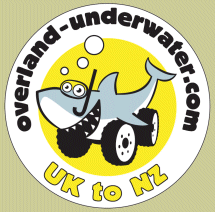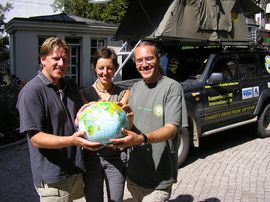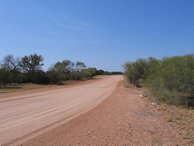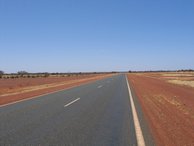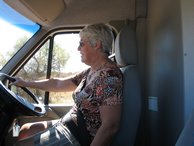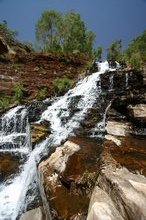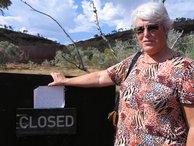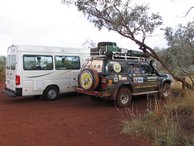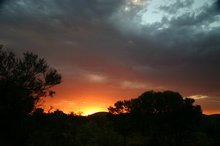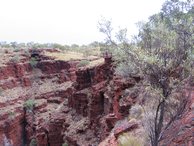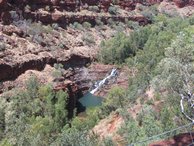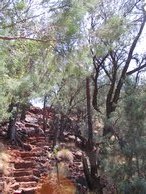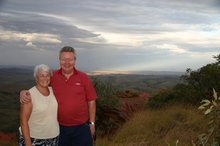| Final Statistics: Alex & Maz | Total distance: 93,550km |
| Furthest Point: Rotorua, NZ | Now settled in Sydney, Australia |
| Final Statistics: Martin | Total distance: 79,698km |
| Furthest Point: Hobart, Australia | Now settled in Bristol, UK |
The Story of “The Grey Nomads”
Australia, Country 26, Diary entry 10th – 13th Dec 2006, Total distance in Australia: Unknown, Distance to date: 16,405KM

COMPETITION TIME COMPETITION TIME COMPETITION TIME COMPETITION TIME COMPETITION TIME
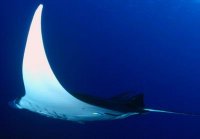
|
The raffle for the diving, dragon visit and accommodation package kindly donated by Reefseekers Diving based in Flores, Indonesia has taken place (by an unnecessarily complicated random method) and the winner is Miguel Sanchez. Congratulations to him, many thanks to all the others for their support and especially thanks to Reefseekers. Thanks to you all, Care International are now another £260 better off. |
COMPETITION TIME COMPETITION TIME COMPETITION TIME COMPETITION TIME COMPETITION TIME

Part 1 of the Grey Nomad Trilogy (Maz’s folks, Jim & Barbara Kelly join us on our adventures downunder)
When Marianne (known to everyone else in the world except her mother and father as Maz) and Alex were planning this drive across the world, neither they nor we anticipated that we would be part of it. However after hearing the adventures of their siblings who had joined them at a number of different stages in their journey, we could not resist the invitation to “come out for Christmas”.
This trip to Australia was very different from our last one. We were on the other side of the continent, and other than in Perth, life is relatively basic. Once you leave the city you are faced with the ochre colour of the earth – at certain times of day a deep orange colour. Distances are vast. We were planning to drive a loop around the West starting in Perth and then moving north, appropriately by ‘the Great Northern Highway’, but don’t let the name confuse. This is a two track tarmac road which, totally unlike English roads, is almost deserted. Some stretches are just long straight lines which move to the horizon – we measured one section which was 10 kilometres long in an absolutely straight line, and not a car or lorry in sight; alone except for the road kill debris of dead kangaroos, the occasional cow or sheep and the fearsome ‘Road Trains’..
These ‘Road Trains’ are something else. Imagine three of the largest lorries allowed in England linked together to one traction unit and you have you ‘Road Train’. The trains travel at 100 kph and take a long time to overtake – getting the overtaking done at the correct place and time is an art form in itself; they slow down for no-one and frequently take up more than their half of the road! They certainly make driving interesting when one meets them
After collecting the campervan and leaving Perth, we had to travel some 1500 kilometres North to meet Marianne and Alex as they drove South to the Karinjini National Park from Port Hedland. Our first stop was in a small township called Calingiri where we had our introduction to camping Australian style. The description in the guide book stated that this was a camping/caravan site with electricity, showers, washing and cooking facilities. Naturally we believed what we read as the guide book was one which had been recommended by and bought in the tourist office in Armadale, just south of Perth.
However, when we arrived in Calingiri we were in for a surprise. After following signs for the Caravan site, we found ourselves beside the main (and only) store in town which had closed at 4.30 pm, in what looked like a deserted ‘car park’ with two block buildings we guessed were public toilets and some poles with grey metal covers. We felt that the guide book had somewhat exaggerated the facilities – until on investigation we found two toilet shower blocks with hot and cold running water, basic but impeccably clean; the poles with metal covers, on further investigation, proved to be live electric supply points.
The town appeared to be almost deserted – one local (we assumed) passed nearby and nodded a hurried hello before moving on. The only instructions were on a notice which informed us, that we should place the appropriate ‘fee’ in a post box on the wall of the Shire Office, which proved to be glass fronted. There was clearly an expectation of honesty in this town, underlined the next morning by the owner of the now open main store who greeted us and never once mentioned payment!
The following two days were spend driving up ‘the Great Northern Highway’ through Mt. Magnet, Meekatharra and Newman towards the Karigini National Park where we had arranged to meet Marianne and Alex. The vast space of the country was emphasized by notices along the way which welcomed us to ‘The Outback’ and many kilometres later it told us that we had crossed the Tropic of Capricorn.
In true Kelly fashion, Marianne was ‘elsewhere’ when we arrived. When we reached the agreed meeting spot, the visitors centre in the middle of the park, 70 kilometres from the next human habitation, we were greeted by a notice on the outside of the centre which said closed. Stuck by cello tape to the closed notice was a sheet of paper, addressed to me and giving us instructions on where we should go to meet them and just in case we missed that notice there was another stuck to a large information board map of the area.
We went and – you’ve guessed it – they were not there – but at least their car was so we knew that we were nearly at the rendezvous. Later that evening we all met up, with much hugging and yelps of joy and we had an excellent first evening in the outback. It was to be the first of many such enjoyable evenings.
Over the next two days we were to enjoy some quite magnificent sights in the natural wildness which is the west side of Australia. The rugged gorges and the large, crystal clear rock pools beneath the tumbling waterfalls in the Karinjini area are spectacular and yet, almost hidden in the landscape. It is almost as if God had taken a very large knife and sliced the earth apart leaving very deep wounds some a 100 metres deep, – but you only see the gorge when you are almost upon it.
Exploring the area was hard work in temperatures in excess of 40°C. But the effort was well worth it. The views from the Oxer Lookout situated at the junction of the Weana, Red, Handcock and Joffre gorges were awesome, with tiers of banded coloured rocks overlooking peaceful rock pools at the bottom of the gorges. Perhaps our favourite location was the picturesque Fortescue Falls and rock pool where, at the bottom of the gorge, two ten meter waterfalls cascade into a swimming hole which is surrounded by lush ferns, fig and paper bark tress.
After clambering down, we all much enjoyed swimming in the cool deep pools at the bottom of the Fortescue Falls – even Barbara – and it gave us all the energy we needed to climb back up to the tope – over 500 meters of scramble and steps.
Our farewell to the Karigini was marked by a sudden rainstorm in this tropical semi desert, which transformed the track from a dusty, dry trail to a swiftly flowing stream in a matter of minutes. The measuring posts beside many heretofore arid roads, indicating possible depths of flooding, suddenly made sense. We drove on, through the storm, to the town of Tom Price, the highest town in Western Australia at some 747 metres above sea level and the site for the Pilbara Iron Mine, one of the biggest iron ore deposits in the world. An ‘off road’ driving track took us to the top of Mount Nameless which overlooks the town and from which there is a stunning view of the area
As with many places in this area, there were frequent references to the Banyima, Kurrama and Innawonga aboriginal people whose traditional home this was – and is, it is an interesting observation that Mount Nameless, so called because the early European settlers had not named it – does have an aboriginal name. The early settler just omitted to ask the Aborigines what the mountain was called, hence its current name.
Camping here for a useful clothes washing session, we encountered our first live kangaroos which were well accustomed to humans and ignored us, unless there was some food for them to eat. They were the first of many native creatures which we were to encounter. Over the coming weeks the younger generation, with frequent exhortations to ‘drink more water or you will become de-hydrated’ were to introduce the ‘grey nomads’ to new pastimes and encounters with the world of nature.
to be continued…
| All content copyright © overland-underwater.com - please do not use without permission. |
